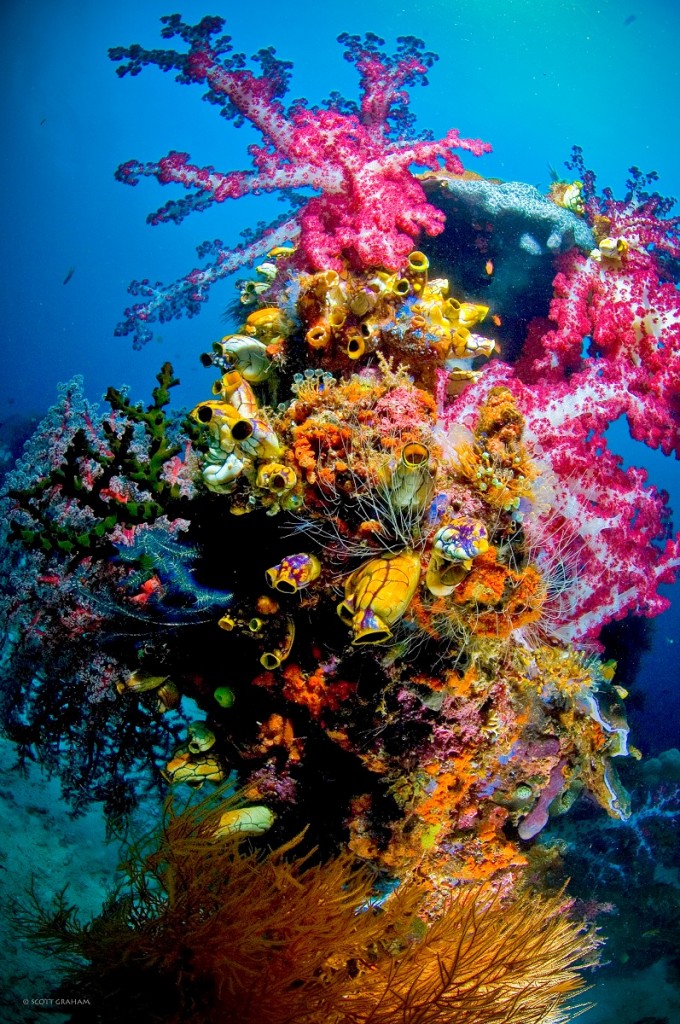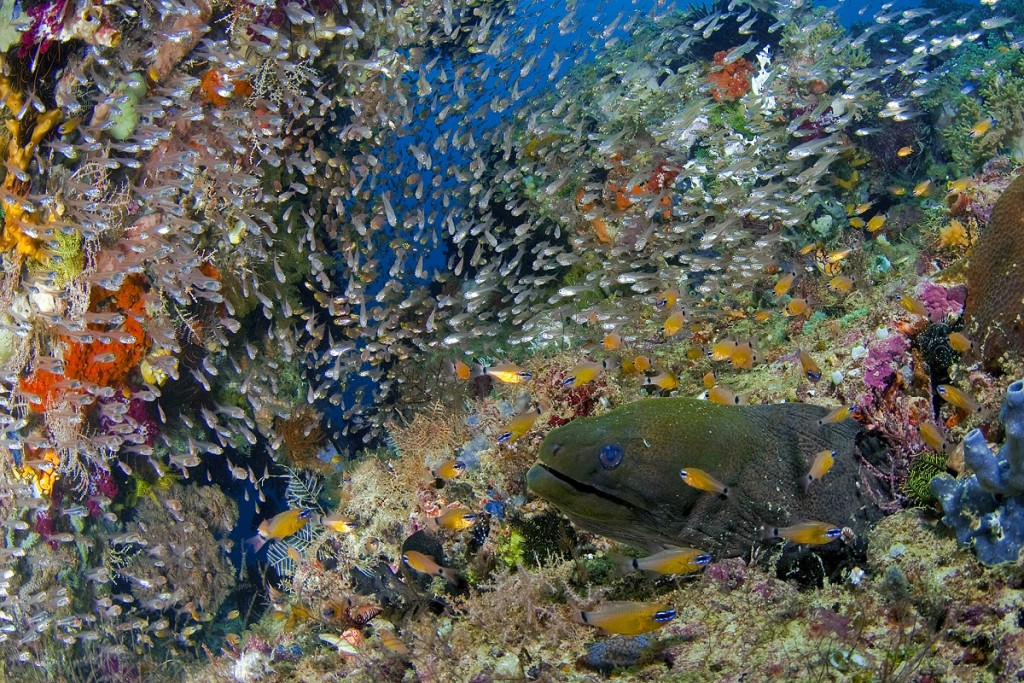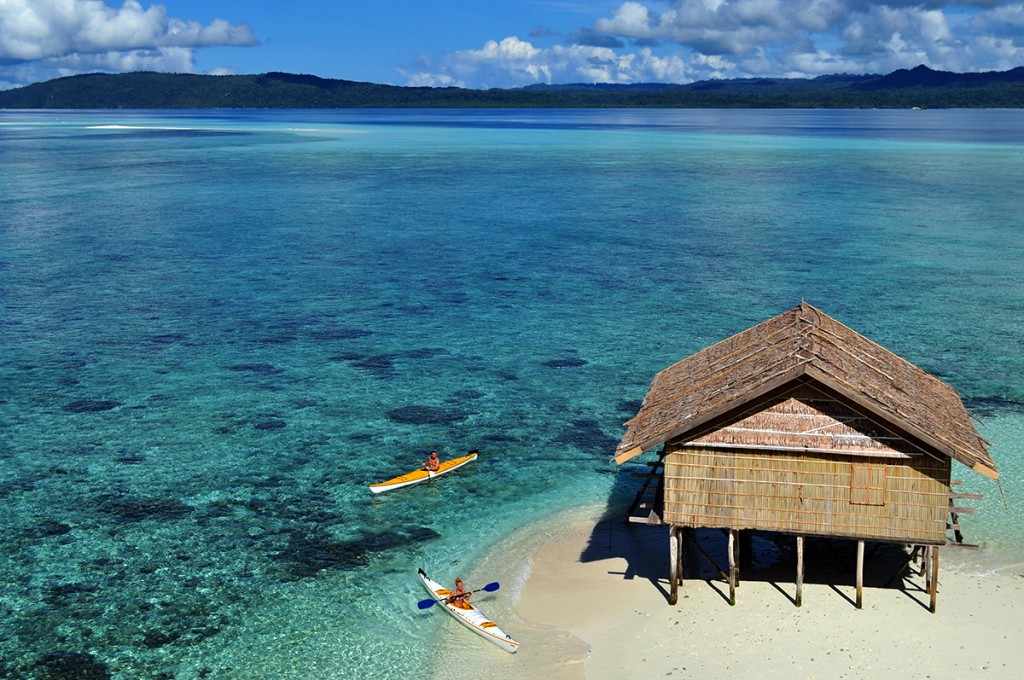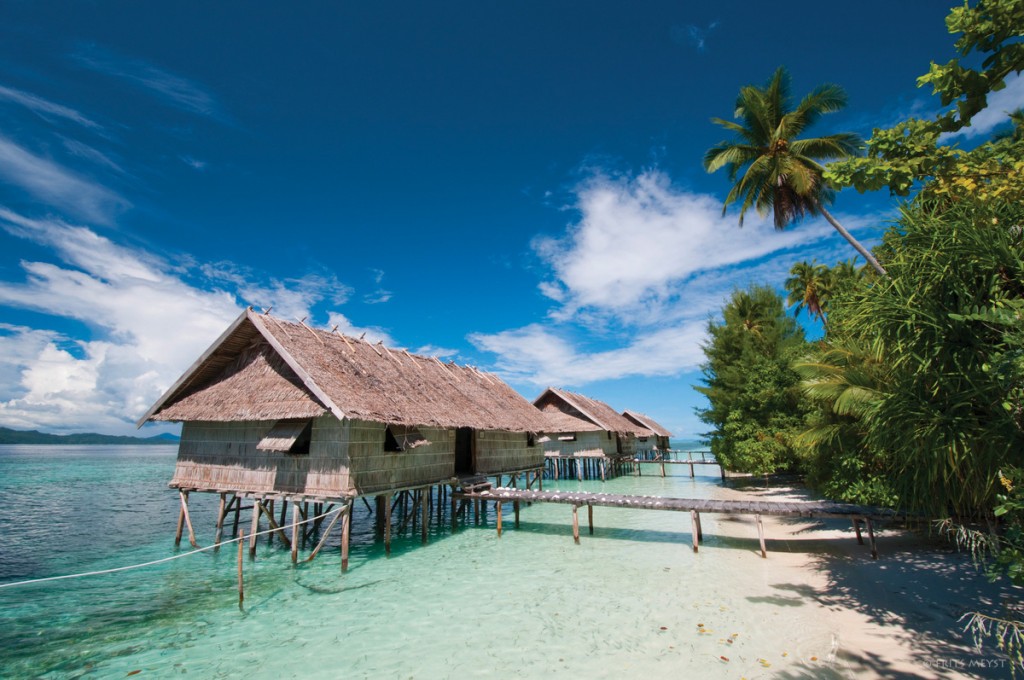News
Jim & Cary Yanny’s Guide to Diving in Indonesia

Part 4: Raja Ampat
Define luxury. Most people would probably say that the word “comfortable” should be included in any sensible definition, but also that it must include being surrounded by plush, expensive items and that the more unaffordable those items are, the more luxurious the experience.
I beg to differ. I know where luxury resides and I can tell you that it’s not where you think is it. Don’t search for it in New York, London, Paris or Milan. No, where I’ve found it, there’s a complete lack of emblems, brands or fancy cars…..or cars of any sort, for that matter. There is a bit of native “bling” in this place, mind you, but even that is not of the type we’ve come to expect, being made mostly of colourful exotic bird feathers.
In this modern age, seven billion noisy souls’ lives are increasingly busy; work is dictated by ever-shortening deadlines, and connectivity is everything. Within this context, the value of material items has reduced a lot and new definitions are starting to replace them. Resources like “space”, “time”, and “peace” are becoming less abundant and therefore much more valuable. In our crowded world, they are the new luxury items of the 21st century.
 The lush Indonesian province of West Papua (or “Irian Jaya”, to use its traditional name) has been almost completely uncharted territory to anyone who isn’t a local or a working in mining, lumber or fishing. That fact remains unchanged for the vast majority of people on the planet; however, recently there has been a growing awareness of West Papua, and of the Raja Ampat area in particular, amongst a tiny group of people consisting mainly of marine biologists and dive tourists.
The lush Indonesian province of West Papua (or “Irian Jaya”, to use its traditional name) has been almost completely uncharted territory to anyone who isn’t a local or a working in mining, lumber or fishing. That fact remains unchanged for the vast majority of people on the planet; however, recently there has been a growing awareness of West Papua, and of the Raja Ampat area in particular, amongst a tiny group of people consisting mainly of marine biologists and dive tourists.
The first indications that Raja Ampat might be an exceptional place for divers came to us about twenty years ago, from a most unexpected source: a young motorbike workshop owner called Max Ammer. The Dutchman had been clued-up that he might be able to find bike and jeeps in mint condition, remnants of the waste of WW2, on these remote islands to refurbish in order to make his fortune. In 1990 Max headed to Papua looking for the bikes, but what he discovered there surprised him. It was indeed riches, but not exactly of the kind he been seeking – the riches Max found were of a natural kind and were like nothing he’d ever imagined: forest canopies bursting with parakeets and other exotic birds, in secret bays with crystal-clear pools.
Then Max started to snorkel off Kri Island’s white-sand beach. What he discovered there blew his mind and changed his life forever. He fell in love with the place and the people (literally, as he married an Indonesian lady) and quickly “recalibrated” his mind from that of a mechanic to one of a conservationist and eco-resort owner. To this day, Max remains on Kri Island, where he runs two resorts under the “Papua Diving” brand. During our twelve years of living in Indonesia we were lucky enough to spend a good deal of time at Max’s Kri Eco Resort & Sorido Bay Resort and we are privileged to be able to count Max amongst our friends.
Raja Ampat was first put on scientists’ radar by the 1998 visit of a renowned Australian fish scientist, Dr Gerry Allen. After that short visit, Dr Allen lobbied Conservation International to conduct a fish survey, which he did with other scientists in 2001. Their findings was an astounding 970 species. On a later survey with his colleague Dr. Mark Erdmann, Dr. Allan counted 374 distinct species on just one 90-minute dive.

I wasn’t even aware that this picture will turn out so crowded when i took it. I was concentrating on the Moray eel, and the blue crack on the back ground. Viewing it later really hit me with the huge amount of fish!
This means that Raja Ampat, quite simply, is home to the richest reefs on Planet Earth. Just off the “Bird’s Head” of West Papua province of Indonesia, it lies in the heart of the Coral Triangle, an area of the western Pacific Ocean that includes the waters of Indonesia, Malaysia, the Philippines, Papua New Guinea, Timor Leste and Solomon Islands and recognised as the epi-centre of marine biodiversity on the planet. The name “Raja Ampat” means The Four Kings in Indonesian, referring to the largest four islands of Misool, Salawati, Batanta and Waigeo. A smaller island of Kofiau and another 1500 islands make up the group, spread over a huge area of 40,000 square kilometres. The population of all these islands of Raja Ampat is tiny – just 50,000.
 Allow me to offer you another definition of luxury: it’s “an exclusivity that makes one feel special and privileged”. If you ask me, being woken up by an “alarm clock” of fish splashing beneath one’s Papuan stilted hut is an especially luxurious way to start one’s day. Relaxing on the end of a jetty overlooking a calm sea and distant islands, waving to the passing fisherman in his canoe but seeing nobody other than him – that’s exclusive and special. Diving on a coral reef and looking up to a forest of trees just above it – that’s unique and special. Having the world’s richest reef as your nearest dive site – that’s very special.
Allow me to offer you another definition of luxury: it’s “an exclusivity that makes one feel special and privileged”. If you ask me, being woken up by an “alarm clock” of fish splashing beneath one’s Papuan stilted hut is an especially luxurious way to start one’s day. Relaxing on the end of a jetty overlooking a calm sea and distant islands, waving to the passing fisherman in his canoe but seeing nobody other than him – that’s exclusive and special. Diving on a coral reef and looking up to a forest of trees just above it – that’s unique and special. Having the world’s richest reef as your nearest dive site – that’s very special.
Resorts in Raja Ampat don’t offer fine dining, they offer fine diving. They don’t offer infinity pools, but there’s an infinite sea. They don’t offer star-studded after-dinner shows, but look up into the black night sky, unpolluted by any city lights and you’ll witness a show of stars that beats anything man can hope to provide. Here is a more natural definition of luxury – it’s provided by Mother Nature herself…..and she’s laid it on in oodles. It’s a luxury defined by a knowledge that so few people ever get to experience this amazing frontier, one of the last pristine wildernesses to be found anywhere on earth. Here the only commuting crowds rushing by have gills, most of the schooling happens to be done underwater and the only call you’ll receive is from a Bird of Paradise flying high overhead.
By immersing oneself in Raja Ampat’s simple yet luxurious nature, something interesting soon becomes clear: that with so many creatures all around us, we’re not missing our creature comforts.
For more information, visit www.diversetravel.co.uk/destinations/Indonesia.
Gear News
Introducing the TR-80, IR-50 and CS-30 Regulators from DYNAMICNORD

Whether you are a beginner or a professional diver – with the three new main regulators from DYNAMICNORD, everyone will find their favourite regulator. They all look super stylish.
Excellent performance with the TR-80
Quality and performance are the be-all and end-all for regulators. It is not for nothing that the TR stands for Tec Reg. The innovative design of the TR-80 guarantees absolute reliability – even in ice-cold waters.

Perfect breathing effort at 0.8 J/l / certified for diving in waters below 10 degrees / structural design made of solid brass for best cold protection / membrane-compensated design with dry seal of the first stage / reduced exhalation effort thanks to optimized exhalation membrane and bubble deflector / adjustable Venturi (dive/predive) and adjustment knob for individual inhalation comfort / innovative design of the front cover prevents free-flow in strong currents or when diving with scooters / design made of sandblasted brass, matt chrome finish / 2 HP and 4 LP outlets / mouthpiece made of high-quality, anti-allergic silicone for maximum comfort.


Amazing underwater adventures with the IR-50
The IR-50 is the top regulator for advanced and experienced divers. Natural breathing is the essence of this regulator.

Ideal breathing effort at 0.8 J/l /certified for diving in waters below 10 degrees / compensated membrane / adjustable venturi (dive/predive) and adjustment knob for individual inhalation comfort/ outlet valve and deflector for minimum exhalation effort and reduction of bubbles on the face / design made of sandblasted brass, matt chrome finish / 2 HP and 4 NP outlets / mouthpiece made of high-quality, anti-allergic silicone for maximum comfort.


The Workhorse – our CS-30
For diving centres and diving beginners – the workhorse stands for strong construction, reliability and robustness. Perfect for your training.

Optimal breathing effort at 0.8 J/l /recommended for diving in waters above 10 degrees / non-compensated piston / adjustable venturi (dive/predive) / outlet valve and deflector for minimum exhalation effort and reduction of bubbles on the face / design made of sandblasted brass, matt chrome finish / 1 HP and 3 NP outlets / mouthpiece made of high-quality, anti-allergic silicone for maximum comfort.


Octopus OP-30
The OP-30 is the ideal addition to all DYNAMICNORD regulators. It is identical in construction to the CS-30.

The TR-80, IR-50, CS-30 (DIN & INT) regulators and the Octopus OP-30 are available from DYNAMICNORD dealers and in the online store.
DYNAMICNORD – Your Outdoor Companion.
Marine Life & Conservation
Paul Watson Released as Denmark Blocks Japan’s Extradition Bid

Renowned anti-whaling activist Paul Watson has been released from custody in Greenland after spending five months in detention. Denmark’s Justice Ministry rejected Japan’s request for his extradition, citing insufficient guarantees that his time already served in custody would be credited against any potential sentence.
The 74-year-old Canadian-American was arrested on July 21 in Nuuk, Greenland’s capital, when his ship docked to refuel. His arrest was based on a 2012 Japanese warrant related to a 2010 encounter in Antarctic waters. Japan alleged Watson obstructed operations and caused damage to a whaling research ship during efforts to disrupt illegal whaling. Watson has consistently denied these claims, maintaining his commitment to marine conservation.
Denmark, which oversees extradition matters for Greenland, concluded that while the legal conditions for extradition were met, the lack of assurances from Japan regarding time-served credit made extradition untenable.
In a video shared by his foundation, Watson expressed gratitude and relief, saying, “After five months, it’s good to be out… and good to know they’re not sending me to Japan.” He added that the most difficult part of his time in custody was being separated from his two young sons.
Watson is a pioneering figure in marine conservation, known for founding the Captain Paul Watson Foundation in 2022 after decades of activism with the Sea Shepherd Conservation Society. His bold efforts to defend marine life have earned him widespread support, including from celebrities and conservationists. His work has also been featured in the acclaimed reality TV series Whale Wars.
Watson’s lawyer, Jonas Christoffersen, praised the decision, stating, “We are happy and relieved that Paul Watson is now free.” He added that Watson is eager to reunite with his family and continue his vital work.
The arrest occurred while Watson’s vessel, the M/Y John Paul DeJoria, was en route to the North Pacific with a team of 26 volunteers to intercept a Japanese whaling ship. His foundation described the arrest as politically motivated and emphasized that Watson’s actions were focused on ending illegal whaling practices.
Japan resumed commercial whaling in 2019 after leaving the International Whaling Commission, asserting that whale meat is a cultural tradition. Conservationists, however, continue to challenge these practices, highlighting their impact on marine ecosystems.
Despite the challenges, Watson remains steadfast in his mission to protect marine life and bring attention to whaling practices. His dedication to ocean conservation has made him a globally respected advocate for the environment.
-

 News2 months ago
News2 months agoIconic SS United States to become the World’s Largest Artificial Reef
-

 News3 months ago
News3 months agoBook Review – 52 Assignments: Underwater Photography
-

 Gear News3 months ago
Gear News3 months agoDYNAMICNORD – New German diving brand enters the British market
-

 News3 months ago
News3 months agoExploring Cenote El Pit: A Diver’s Dream
-

 Gear News3 months ago
Gear News3 months agoTry BARE drysuits (and maybe even win one!) this Friday with Sea & Sea at North West Dive Fest
-

 Marine Life & Conservation3 months ago
Marine Life & Conservation3 months agoBook Review: Coral Triangle Cameos
-

 Blogs2 months ago
Blogs2 months agoDive the Egyptian Red Sea this Autumn with Regaldive
-

 News3 months ago
News3 months ago2024 Ocean Art Underwater Photo Competition Announced


















